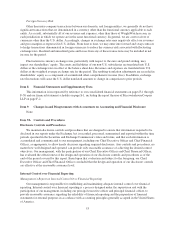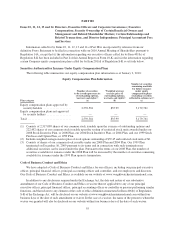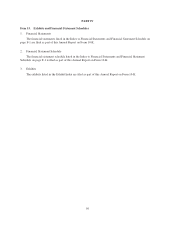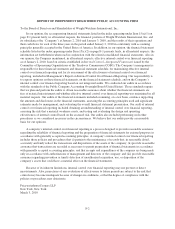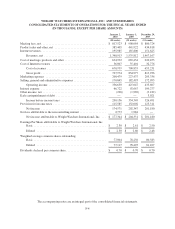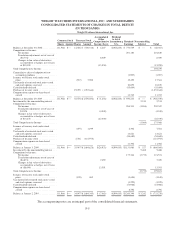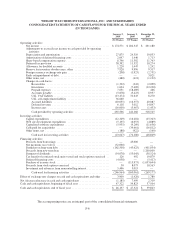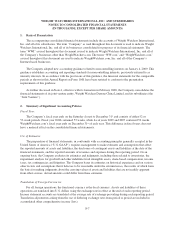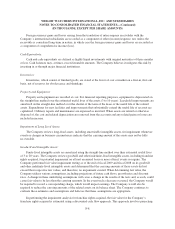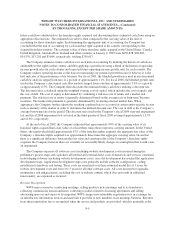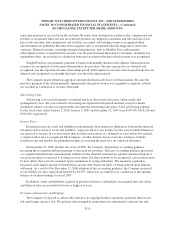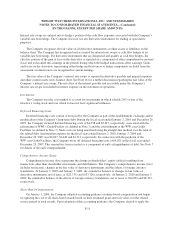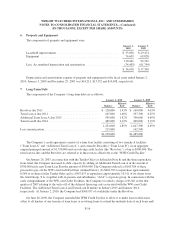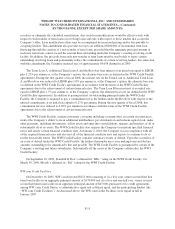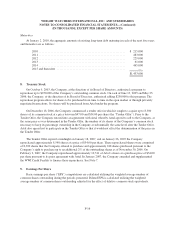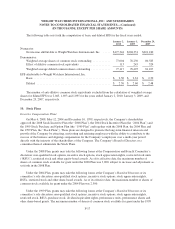WeightWatchers 2009 Annual Report Download - page 79
Download and view the complete annual report
Please find page 79 of the 2009 WeightWatchers annual report below. You can navigate through the pages in the report by either clicking on the pages listed below, or by using the keyword search tool below to find specific information within the annual report.WEIGHT WATCHERS INTERNATIONAL, INC. AND SUBSIDIARIES
NOTES TO CONSOLIDATED FINANCIAL STATEMENTS
(IN THOUSANDS, EXCEPT PER SHARE AMOUNTS)
1. Basis of Presentation
The accompanying consolidated financial statements include the accounts of Weight Watchers International,
Inc. and all of its subsidiaries. The term “Company” as used throughout this document is used to indicate Weight
Watchers International, Inc. and all of its businesses consolidated for purposes of its financial statements. The
term “WWI” as used throughout this document is used to indicate Weight Watchers International, Inc. and all of
the Company’s businesses other than WeightWatchers.com. The terms “WW.com” and “WeightWatchers.com”
as used throughout this document are used to indicate WeightWatchers.com, Inc. and all of the Company’s
Internet-based businesses.
The Company adopted new accounting guidance related to noncontrolling interests on January 4, 2009. This
guidance establishes accounting and reporting standards for noncontrolling interests, previously referred to as
minority interests. In accordance with the provisions of this guidance, the financial statements for the comparable
periods as shown in this Annual Report on Form 10-K have been restated to conform to the presentation
requirements of this guidance.
As further discussed in Note 4, effective with its formation in February 2008, the Company consolidates the
financial statements of its joint venture entity, Weight Watchers Danone China Limited, and its subsidiaries (the
“Joint Venture”).
2. Summary of Significant Accounting Policies
Fiscal Year:
The Company’s fiscal year ends on the Saturday closest to December 31st and consists of either 52 or
53-week periods. Fiscal year 2008 contained 53 weeks, while fiscal years 2009 and 2007 contained 52 weeks.
WeightWatchers.com’s fiscal year ends on December 31st of each year. This difference in fiscal years does not
have a material effect on the consolidated financial statements.
Use of Estimates:
The preparation of financial statements, in conformity with accounting principles generally accepted in the
United States of America (“U.S. GAAP”), requires management to make estimates and assumptions that affect
the reported amounts of assets and liabilities, the disclosure of contingent assets and liabilities at the date of the
financial statements, and the reported amounts of revenues and expenses during the reporting period. On an
ongoing basis, the Company evaluates its estimates and judgments, including those related to inventories, the
impairment analysis for goodwill and other indefinite-lived intangible assets, share-based compensation, income
taxes, tax contingencies and litigation. The Company bases its estimates on historical experience and on various
other factors and assumptions that it believes to be reasonable under the circumstances, the results of which form
the basis for making judgments about the carrying values of assets and liabilities that are not readily apparent
from other sources. Actual amounts could differ from these estimates.
Translation of Foreign Currencies:
For all foreign operations, the functional currency is the local currency. Assets and liabilities of these
operations are translated into U.S. dollars using the exchange rate in effect at the end of each reporting period.
Income statement accounts are translated at the average rate of exchange prevailing during each reporting period.
Translation adjustments arising from the use of differing exchange rates from period to period are included in
accumulated other comprehensive income (loss).
F-7


